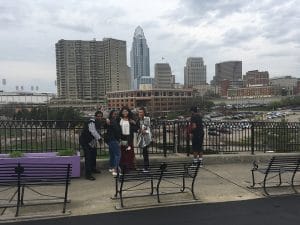By Lynn Sygiel, editor, Charitable Advisors
For Linda Foster, 16, and Taneiscia Persinger, 15, middle school was a struggle. Both had blase attitudes about school, which were reflected in their grades.
Then about three years ago, they each had a relative who cajoled them to join the Boys & Girls Club in their neighborhoods. That’s when things began to turn around. Now the sophomore and freshman give education a “5” in its importance and both have aspirations to attend college.
“In my family, my mom, my grandma, my aunt, my great grandma, none of them went to college. I want to be the first girl in my family to actually go to college and break that chain,” said Foster, who attends Arsensal New Tech High School.
Persinger believes that education is imperative for everything – to drive, to write to read.
Why did their attitudes toward school change?
Foster credits the after-school and summer programs at Wheeler-Dowe at 30th Street and Keystone Avenue and Persinger the Keenan-Stahl club on Troy Avenue.
“There are a lot of staff members who care about my education and me making it somewhere. They’re all different. They all push you in different ways, and I say the staff member that pushes me the most and keeps it most real with me is Miss Bria Amons because she doesn’t sugarcoat anything,” said Foster.
According to LeeAnn Harris, the director of club operations, education has always been a key program component, but for the past six years, college and career readiness has become a club priority. Working for the clubs since 1989, Harris has seen lots of societal changes including lack of involvement of parents involvement, all part of what spurred a conversation in 2011 to fine tune the clubs’ focus and investment.

“What impact do you want to say you had on that young person? What skills do you want them to leave with? What attitudes do you want them to leave with? What do you want them to take away?”
At the first discussion with the clubs’ 130 staff members, three big areas emerged — job readiness/academic success, healthy lifestyles and character and leadership development.
After that meeting, Harris reached out to individual clubs. While she walked away from those conversations confident that if any staff member who overheard kids talking about delinquent activity, they would intervene, she also recognized that 90 percent of club staff watched kids walk daily and chuck their backpacks in the corner. As Harris and club leadership saw it, academic success and job readiness had the most potential for growth.
“It wasn’t our natural responsibility. But because of who we are, because we care about kids, because staff said it’s important to see kids be academically successful, it became our responsibility to do something about it,” said Harris.
Next, Harris started collecting data on club attendees — ISTEP pass-rate data, graduation data and the school-dropout data for the feeder schools for each of the clubs – to identify the need and create a baseline measurement.
In the fall of 2011, each club added a full-time education director. Lilly Endowment helped pay for a two-year project with the Center for After-School Education, providing professional development for full-time and part-time staff. The center’s staff observed club programs and helped staff write action plans to improve programming and recommended regularly sharing learning activities between clubs. Now, every month at staff meetings, the host staff begins by engaging the group in a high-yield learning activity.
It didn’t take long for to realize that one education director for each Boys & Girls club wasn’t enough and in the fall of 2012, the clubs added full-time graduation counselors.

Now instead of putting the backpacks in the corner, each club has a daily Power Hour where the emphasis is on homework. Everyone at the club is engaged in learning activities, working on tomorrow’s homework, a long-term school project or investing time in enrichment-learning activities. Clubs involve kids in a Career Launch curriculum to expose them to different careers and the difference between a job and career. Last summer the clubs offered Take-a-Girl-to-Work Day, and this summer the clubs will add boys. One of the topics the clubs asked the volunteer professional to discuss with the kids was benefits.
“We had to break that down for the volunteers and say, ‘We don’t mean explain your 501(c) 3, your 401(k), just tell them you get paid even when you are sick. That will blow their minds.’
“There are few if any people in the lives of most of our club members who get paid sick time or get paid vacation share time. They’re amazed you have a refrigerator where you work, and you can get free soda. You get a lunch break and you get paid while you’re eating lunch. Most of the people in their lives have jobs, and they don’t know that there are other options,” said Harris.
According to Harris, when the college readiness program first started, kids had unrealistic ideas about school. Some thought they were to going to go to UNC and play basketball just because they wanted to. She shared a story about a high school student who didn’t realize she had to pass classes to graduate from high school. She had taken all the classes on the list to get her Core 40 diploma, but didn’t realize until she approached graduation that she wouldn’t be graduating.
“There is no one telling them that information. What we’re trying to do is to create opportunities for our young people to be able to get good jobs that will support them and allow them to live the life that they want for themselves. It’s understanding what the difference between a job and a career and what benefits are.”
Originally, Hurdish wanted formal graduation plans for each student, but realized it needs to be more informal.
“A lot of the focus for College Readiness has been understanding that college doesn’t have to mean a traditional four-year school. I think some of the kids think that’s the expectation, and if that’s not what they’re going to do, then there’s really no place for me in this conversation,” said Hurdish.
To get to those conversations, Hurdish begins with talking about personal and family barriers and then branching off that.
“Before we can talk about the logistics like SATs and GPAs and all that, just having conversations about what are barriers to getting to college. A lot of times the answer is, ‘I don’t know if I’m even going to graduate high school.’ Or ‘there’s no way I’m going to be able to afford it,’” she said.
Teenagers have the opportunity to tour college campuses in the fall and spring. They earn points for volunteering with younger kids, leadership tasks and involvement in college readiness activities. There are also tours of Indiana campuses for younger teens. The overall goal is to give urban students exposure to college life.
Hurdish said that the college tours have had a ripple effect.
“The college tours have become a big thing. The teams are really into it and feel set apart if they go on a trip. And so I think what happens that’s even cooler, is they go back to the club and they talk about it, and we hang up pictures of the trip. It’s part of the conversation starter with other kids,” she said.
Over spring break, club members, their graduation counselors and Hurdish traveled to Ohio to tour two colleges and spent time at a Cincinnati Boys & Girls Club. In advance of the tour, each student had to research a school and develop questions for tour guides. Their questions — What is it like on campus? How many people stay in one dorm? What does your GPA have to be to go? – help them change some of the previous misconceptions and mindsets.
Foster and Persinger were part of the group of 24 that visited Wilberforce University, the first private HBCU, and the University of Cincinnati, which has the first living-learning community on a campus that focuses on first-generation college students.
Both Foster and Persinger were intrigued by Wilberforce.
“Wilberforce caught my eye. I knew right when I stepped on the campus, it was just so small, but there was kids communicating. All the groups came together, so it wasn’t like a rivalry. They were like, ‘How you doing today?’” said Persinger.
It also prompted more questions and reflections.
“How am I going to get there because I’m not going to be able to pay for that? But the B&G Club, that’s my rescue to get to college, because I know that they can help,” said Persinger.
And that includes getting them enrolled for the 21st Century Scholars program, so that they have access to resources. There are regular check-ins to see if teens are completing the requirements.
Persinger is hopeful that there is another resource.
According to Harris, the Boys & Girls Clubs of Indianapolis has the largest endowed scholarship program of any in the country. Started privately, CICF manages 28 funds, the Dr. James R. East Scholarship Programs.
Scholarships are available to any graduating senior going on to a post-secondary institution, which could be vocational, two-year or four-year programs. One requirement is that the applicant must have been a member for at least three years at any age.
In 2013, when Harris began to manage the scholarship, four teens applied. Last year, four years after graduation counselors were in place, 15 applied.
“I think that impact in four years speaks volumes about how important those graduation counselors and college readiness program were. My goal is if we can stay at that higher number and keep kids in school, then we end up utilizing each of those scholarship funds. I would love to have that challenge,” said Harris.

